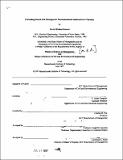| dc.contributor.advisor | E. Sarah Slaughter and Charles H. Fine. | en_US |
| dc.contributor.author | Stewart, Kevin Michael | en_US |
| dc.contributor.other | Leaders for Manufacturing Program. | en_US |
| dc.date.accessioned | 2009-02-17T17:24:42Z | |
| dc.date.available | 2009-02-17T17:24:42Z | |
| dc.date.copyright | 1997 | en_US |
| dc.date.issued | 1997 | en_US |
| dc.identifier.uri | http://hdl.handle.net/1721.1/44602 | |
| dc.description | Thesis (M.B.A.)--Massachusetts Institute of Technology, Sloan School of Management; and, (S.M.)--Massachusetts Institute of Technology, Dept. of Civil and Environmental Engineering; in conjunction with the Leaders for Manufacturing Program at MIT, 1997. | en_US |
| dc.description | Includes bibliographical references (p. 117-118). | en_US |
| dc.description.abstract | This thesis studies the life-cycle of semiconductor facilities and the potential roles that they may play once they reach the end of their life. Specifically, the author's findings are based on studies associated with the decommissioning of a semiconductor manufacturing facility ("fab") at the Intel Corporation's Aloha Campus in Portland, Oregon. With increasing demarids for its products, Intel is constructing newer and more modern facilities to support large-scale manufacturing efforts. As newer product lines and facilities come on line, older product lines are being eliminated and older semiconductor facilities that produced them are consequently being shut down largely without regard for what their use will be afterwards. As such, this study starts by first looking at the concept of facility life-cycle with respect to semiconductor manufacturing facilities. After discussing potential pre-shutdown planning requirements, the author presents an empirical framework for evaluating possible roles that these fabrication facilities could play after they are taken out of service. In brief, the framework consists of five general steps - (1) establish reference state; (2) develop list of alternatives; (3) establish decision factors; (4) generate measures for comparison; and (5) compare and contrast to draw conclusions -and is based upon a thorough consideration of all relevant technical, strategic, and financial issues. The paper then applies the framework to a current semiconductor manufacturing facility that was the focus of this research. The example developed for Intel's Fab 4 demonstrates that a combination of a short-term role (utilizing the building as a manufacturing support platform) and a long-term strategy (combining the resources of Fab 4 and Fab 5) appears to be the "most feasible" set of alternatives. In addition, the methodology is then applied to other examples of past and potential future wafer fabrication facility decommissioning projects. Conclusions from this research indicate that a process-oriented (rather than outcome-oriented) framework best captures the iterative and dynamic nature of the problem. As such, the major contribution of this methodology is that it presents a framework for how to think about the problem rather than how to immediately solve it. As such, the author believes that the research results presented herein are not intended to be a panacea for what remains to be a difficult problem. However, since companies will no longer be able to walk away from existing facilities, the author concludes that incremental investment and planning for adaptive re-use during the facility's lifetime would appear to offer numerous advantages over waiting until after it is shut down. | en_US |
| dc.description.statementofresponsibility | by Kevin Michael Stewart. | en_US |
| dc.format.extent | 178 p. | en_US |
| dc.language.iso | eng | en_US |
| dc.publisher | Massachusetts Institute of Technology | en_US |
| dc.rights | M.I.T. theses are protected by
copyright. They may be viewed from this source for any purpose, but
reproduction or distribution in any format is prohibited without written
permission. See provided URL for inquiries about permission. | en_US |
| dc.rights.uri | http://dspace.mit.edu/handle/1721.1/7582 | en_US |
| dc.subject | Sloan School of Management. | en_US |
| dc.subject | Civil and Environmental Engineering. | en_US |
| dc.subject | Leaders for Manufacturing Program. | en_US |
| dc.title | Evaluating end-of-life strategies for decommissioned semiconductor facilities | en_US |
| dc.type | Thesis | en_US |
| dc.description.degree | S.M. | en_US |
| dc.description.degree | M.B.A. | en_US |
| dc.contributor.department | Leaders for Manufacturing Program at MIT | en_US |
| dc.contributor.department | Massachusetts Institute of Technology. Department of Civil and Environmental Engineering | |
| dc.contributor.department | Sloan School of Management | |
| dc.identifier.oclc | 48215652 | en_US |
